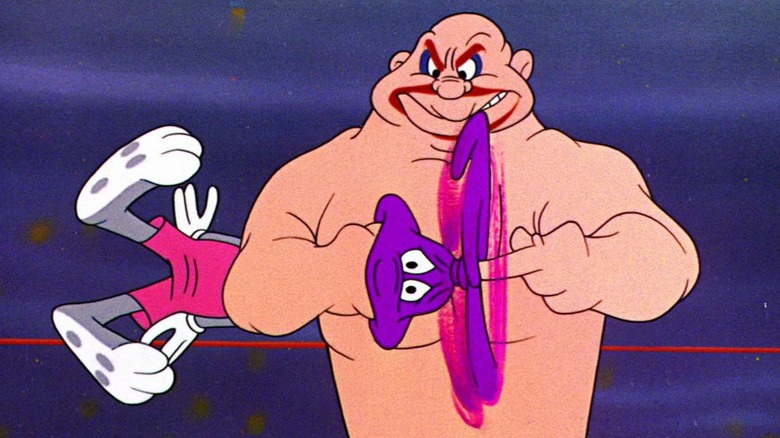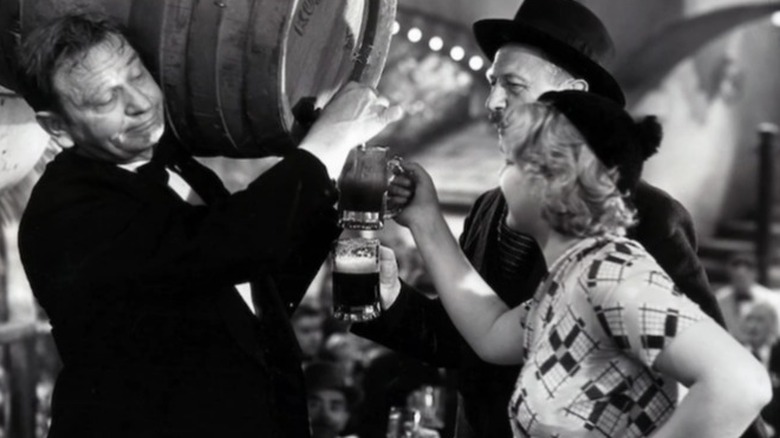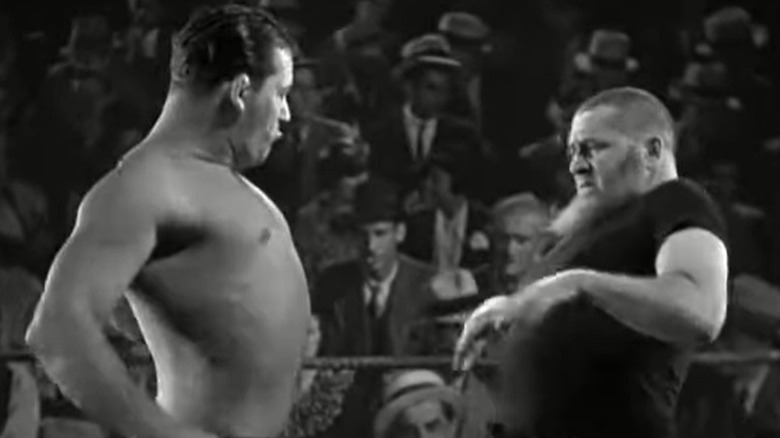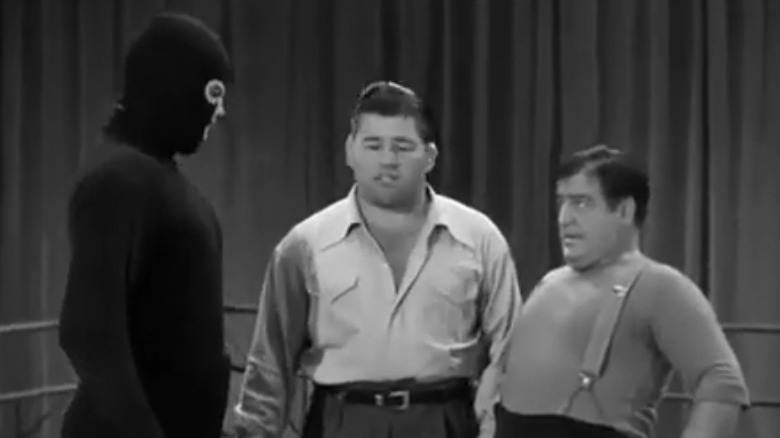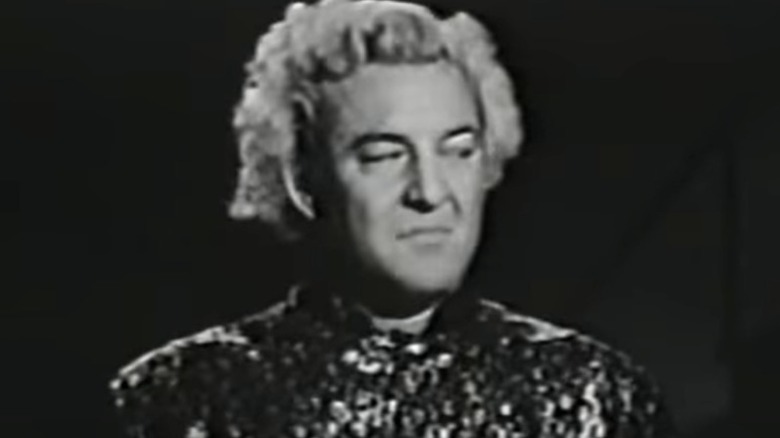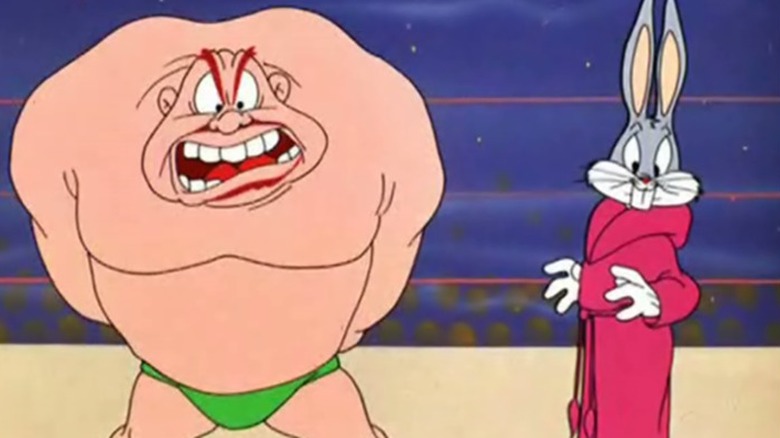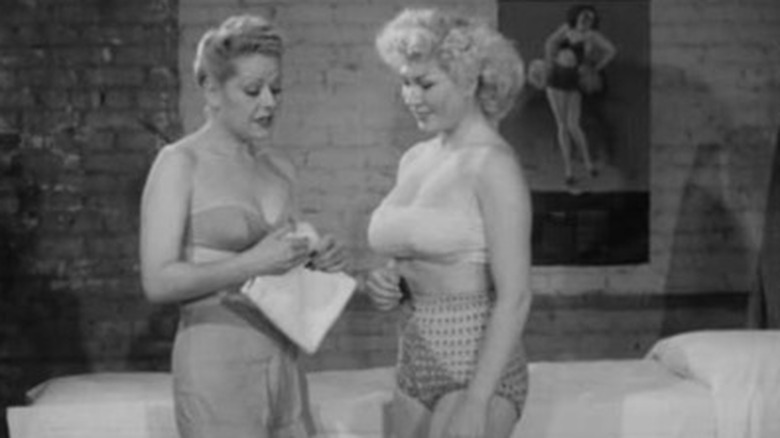10 Notable Wrestling Movies From The Golden Age Of Hollywood
The Golden Era of Hollywood could roughly be measured from the dawn of the California-based film industry in the mid-1910s through the end of the 1950s. Professional wrestling would occasionally turn up in the films of this period, sometimes as the central focus to the story and other times as a plot peg to drive a wider story.
For the student of professional wrestling history, these films offer an invaluable consideration of how wrestling was viewed. In many of the films, wrestling was depicted as a mobster-run endeavor and the wrestlers were honest men who were surprised to find themselves within a criminal element who demanded fixed fights.
Some of the films of this genre recruited the popular wrestlers of the day. When wrestling gained a new wave of popularity in the early days of television, a flurry of films emerged to cash in on the growing interest in the promotions.
For your consideration, here are 10 of the most intriguing wrestling-related films created during this illustrious epoch of cinematic output.
Flesh (1932)
Few wrestling films have a talent line-up equal to this Metro-Goldwyn-Mayer production: John Ford was the director, Broadway playwright Moss Hart and an uncredited William Faulkner worked on the screenplay, and the cast included Wallace Beery (fresh from his Oscar-winning role in "The Champ"), Jean Hersholt, and Ricardo Cortez.
Beery plays Polokai, a genial but simple-minded wrestler who is Germany's national champion. He falls in love with Laura (Karen Morley), an American convict just released from a German prison, and she convinces him to sail across the Atlantic with her. But Polokai finds the American wrestling world is run by gangsters who are eager for him to fail.
"Flesh" took advantage of the progressive Pre-Code Hollywood era by having Laura become pregnant out of wedlock. Polokai marries her, even though she is aware he is not the father of the baby. The film also acknowledges the failure of Prohibition by having Polokai lapse into heavy drinking when he is in America.
Ford was a last-minute replacement as director after Raoul Walsh and Robert Z. Leonard were hired and withdrawn. The master filmmaker, who would later win four Academy Awards for Best Director, had little fondness for the finished film, as he requested to have directing credit removed before it was released (although the film was released as "A John Ford Production"). The studio initially announced that silent movie star Colleen Moore was to make her sound film debut with "Flesh," but Morley was cast instead.
The concept of a Wallace Beery wrestling film was a plot peg of Joel and Ethan Coen's 1991 "Barton Fink," although the Coens said they were unaware of "Flesh" when they created their film.
Grips, Grunts and Groans (1937)
This 1937 comedy short stars the Three Stooges (Moe, Larry, and Curly) as hobos who are thrown off a train. They somehow find themselves at the Hangover Athletic Club, where they are befriended by the world champion wrestler Ivan Bustoff, a gregarious bearded man with a fondness for booze. Local mobsters have bet their money on Bustoff for a match scheduled for that evening and hire the Stooges to ensure the wrestler doesn't get drunk. The slapstick trio somehow knock Bustoff unconscious by dropping dumbbells on his head, so they cut and paste Bustoff's bushy beard on Curly's chin to pass him off as the ring champion.
During the match, Curly is clobbered by his opponent, an oversized wrestler known as Ironhead. However, Curly has a weird quirk where he unleashes superhuman strength if he is exposed to a perfume brand called Wild Hyacinth. Moe spots a woman in the audience with that brand of perfume, who splashes it on Curly. Newly incensed by the perfume, Curly pummels Ironhead -– along with everyone who tries to stop him before he knocks himself out by flinging the ring bell on his head.
Ironhead was played by Casey Columbo, who performed in several wrestling promotions under a variety of names including Count de Collelmo. He also had a bit part as a hospital patient on the receiving end of Stooges-fueled mayhem in the 1937 "Dizzy Doctors." The burly character actor Harrison Greene played the drunken Bustoff.
Swing Your Lady (1938)
This Warner Bros. comedy takes place in the Ozarks where wrestling promoter Ed Hatch (played by Humphrey Bogart) and his wrestler Joe Skopapoulos (Nat Pendleton) are trying to scare up competition for wrestling tournaments. An Amazonian lady blacksmith (former silent movie comedy star Louise Fazenda) catches their attention and Ed plans a match with Joe taking on this "Herculette." But when the two fall in love, Ed scrambles to find a replacement match that pits Joe against the blacksmith's ex-beau. Ed tries to break up the romance between his wrestler and blacksmith, but true love prevails and he winds up taking the pair to New York City after Joe gets an offer to wrestle at Madison Square Garden.
Bogart's presence in "Swing Your Lady" was a bizarre bit of casting –- the actor had achieved film stardom playing intense gangsters in the 1936 films "Dead End" and "The Petrified Forest," and having him cast as a wrestling promoter in a B-level hillbilly comedy seemed like a step backward. Another actor trying to secure stardom, Ronald Reagan, had a bit part
To its credit, the film brought in two professional wrestlers for the climactic match. Pendleton was an Olympic wrestler who became a professional wrestler before switching careers into acting. His athletic presence and ability to seem sinister made him a memorable foil for the Marx Brothers in "Horse Feathers" and Abbott and Costello in "Buck Privates." His foe in the big match was Daniel Boone Savage, a bearded giant who wrestled under several names including Leo Savage, Bull Civil, and Whiskers Savage.
Here Come the Co-Eds (1945)
This Universal comedy finds Bud Abbott and Lou Costello as caretakers at a financially troubled all-girls school. The duo devise schemes to quickly raise money for the school, including a wrestling match where Costello takes on a hulking athlete known as the Masked Marvel. Abbott makes a deal with the Masked Marvel to throw the bout so the school can win the $1,000 tournament prize, but the wrestler becomes ill prior to the match and is secretly replaced by the pair's hostile supervisor, Mr. Johnson (played by Lon Chaney Jr.).
Costello goes into the ring believing the bout will be in his favor, but from the beginning things go against him –- the referee explains the rules of the match by showing all of the illegal moves on Costello. As the match unfolds, Costello mostly gets banged about –- but through a fluke he manages to win, only to be knocked out when he is punched in the face by his own fist while his arm is raised in victory.
Costello first came to Hollywood as a stuntman in the mid-1920s and did much of the stunt work for this sequence, which included his falling over the ropes, getting smacked around and having his head banged into the mat -– the latter indignity included having the Masked Marvel's corner man put a walnut on the mat for Costello's head to break its shell. A stunt man was used for Costello in long shots, but that individual was visibly taller and thinner than the zany comic; Chaney's character was masked through nearly all of the sequence and it is unlikely the actor did his own stunts.
The comics would return to wrestling in 1950's "Abbott and Costello in the Foreign Legion," where they played wrestling promoters who follow their star athlete to Algeria and wind up in the French military outpost.
Alias the Champ (1949)
The dawning of the television era in the late 1940s propelled wrestler Gorgeous George to national stardom, and this 1949 quickie from the low-budget Republic Pictures was designed to cash in on his success and the popularity that wrestling had with TV viewers of that era.
In this drama, George is managed by Lorraine Connors (Audrey Long), who is dating wrestler Sammy Menacker (also playing himself). A police lieutenant (Robert Rockwell) is quietly investigating mob ties to the wrestling matches, but when George and Sammy get into a quarrel over Lorraine, the lieutenant suggests they settle the matter in the ring. Sammy dies during the bout and George is suspected of murder –- but the lieutenant saves the day when he views a rebroadcast of the match and realizes how Sammy really died.
With a 60-minute running time, "Alias the Champ" was strictly meant as the lower half of double feature presentations. "Alias the Champ" is also notable for populating its supporting cast with prominent wrestlers of the early television era. In addition to George, the wrestlers in the film include Bomber Kulkovich, Billy Varga, Bobby Manogoff, George Temple, and Jack "Sockeye" McDonald.
However, one of the wrestlers in a supporting role would late gain immortality as the star of some of the most wonderfully bad films ever made: Tor Johnson, who wrestled as the Super Swedish Angel, would become part of Edward D. Wood Jr.'s bizarre ensemble and co-star is the Grade Z classics "Bride of the Monster" and "Plan 9 from Outer Space."
Bodyhold (1949)
Also in release during 1949 was this B-level Columbia Pictures wrestling drama. Tommy Jones (Willard Parker) is a plumber with an athletic physique. His girlfriend (Lola Albright) convinces him that he should become a professional wrestler and arranges for him to become part of a promotion. But Tommy discovers to his shock that the promotion is run by gangsters and the matches are crooked.
Unlike "Alias the Champ," "Bodyhold" does not populate its cast with well-known wrestlers; Parker worked in Hollywood in supporting roles since the late 1930s and this film gave him a rare opportunity for a leading part.
Columbia packed the supporting cast with recognizable character actors including Hillary Brooke, Allen Jenkins, Roy Roberts, Gordon Jones and John Dehner. Albright was considered an up-and-coming talent at the time, although she never reached her full potential as an actress until the idiosyncratic 1961 drama "A Cold Wind in August."
With a 63-minute running time, "Bodyhold" covers a lot of ground -– and while the cheapjack budget is hard to ignore, the film's speed and tough spirit is entertaining. Perhaps if more time and care had been given to the film, it might have been better remembered.
Night and the City (1950)
This film noir thriller is set in London, where aspiring wrestler Harry Fabian (Richard Widmark) seeks to make his mark in the city's wrestling scene. He convinces an aging wrestling champ Gregorious (Stanislaus Zbyszko) to pit his son Nikolas (Ken Richmond) in a match against the Strangler (Mike Mazurki), who works as a henchman for a local crime kingpin (Herbert Lom). But Harry finds himself out of his depth in a criminal environment where his scheming goes awry and his wrestling promotion dreams turn into violent tragedy.
"Night and the City" is unusual in having a London setting for the type of wrestling-gangster drama that was traditionally an American experience. Part of this was due to the source material, the 1938 novel by British writer Gerald Kersh, and part was due to the political climate at the time of the film's production — director Jules Dassin was being targeted for McCarthy-era blacklisting, so his studio 20th Century Fox sent him to London with several American actors including Widmark, Mazurki and leading lady Gene Tierney to fulfill his contract without interruption from McCarthy-era investigators.
Zbyszko was a wrestling champion during the 1920s, and Dassin cast him even though he had no acting experience, stating that he "didn't want to pick an actor and train him to be a wrestler -– I wanted to do the opposite." Richmond was an Olympic wrestling champion, but never worked in professional wrestling, while Mazurki was an attorney who became a professional wrestler because it was more financially lucrative – he would later become one of the most prominent character actors in Hollywood, specializing in gangster roles.
"Night and the City" would be remade in 1992 starring Robert De Niro, but the wrestling plot was replaced with a boxing storyline.
Bunny Hugged (1951)
This Merrie Melodies short from the Warner Bros. animation studio stars Bugs Bunny in a parody of the wrestling matches that were popular on television in the early 1950s. Bugs is the mascot of Ravishing Ronald, a Gorgeous George clone who is identified as "the de-natured boy" (a riff on Buddy Roger's nickname "Nature Boy"). Ronald's opponent is the fierce brute called the Crusher, who immediately immobilizes Ronald by tying him up in his hairnet and using him as a punching bag.
Bugs springs into action as a last-second substitute for Ronald called "The Masked Terror" -– he has a purple covering over his head –- but his wrestling skills are even worse than Ronald's. Crusher spins Bugs' long ears and he goes flying around the ring like a propeller-driven airplane before getting trapped in Crusher's brutal leg scissors.
But Bugs turns the tables by employing "a little stragety." The rest of "Bunny Hugged" has surreal sight gags including Bugs disguised as a tailor to mend Crusher's trunks –- he stabs the wrestler with a giant needle in his backside, causing him to fly out of the ring screaming -– and then slams a giant safe door on Crusher's head (don't ask why or how). Crusher is literally pinned to the mat (Bugs puts a coat on the dazed wrestler and uses safety pins to fasten him to the ground).
"Bunny Hugged" is something of a sequel to the 1948 "Rabbit Punched," which used a boxing match instead of wrestling and had Crusher appear under the name Battling McGook.
Mr. Universe (1951)
This B-level comedy starred Vince Edwards as Tommy Tomkins, the winner of a bodybuilding championship who gets steered by a con man (played by Jack Carson) into becoming a professional wrestler. All goes well for Tommy at first, as his athleticism helps him rise to the top of the wrestling world. But when gangsters try to force him to throw a match, Tommy becomes disillusioned with the wrestling world and tries to maintain his honesty.
"Mr. Universe" is something of an oddity. Made on an obvious low budget at the cheapjack Eagle-Lion Studios, the film managed to pack its cast with A-list actors including Carson, Janis Paige as his girlfriend, Bert Lahr as Tommy's manager, Robert Alda as the match-fixing mobster and Maxie Rosenbloom as Tommy's trainer.
For students of wrestling history, "Mr. Universe" is notable for having several top-named wrestlers of the era in guest appearances: Chief Flying Mare, The Missing Link, Gorilla Hogan, Newton the Teuton, Delightful Dave, Gregorivitch the Magnificent and The Hoboken Turk show up, along with Dennis James, a prominent ringside announcer of the era.
The comedy in "Mr. Universe" is of a Damon Runyon picaresque nature, with Carson and Lahr doing most of the comic heavy lifting. This was Edwards' first starring role, but comedy was not his specialty, and the film did not secure him any degree of name recognition -– that would come 10 years later when he played the title role in the popular TV series "Ben Casey." A future comedy star was also on screen -– a young Joan Rivers was an extra, although she is not clearly visible to the viewer.
Racket Girls (1951)
Women's wrestling was mostly ignored during Hollywood's Golden Age, although an exception was made with this cheap little independently produced feature.
Umberto Scalli (Timothy Farrell) is prominent as the manager of a women's wrestling promotion but, in reality, he is a gangster who uses the promotion as a cover for his endeavors in money laundering, rigging horse races, bookmaking, and sex work. He has trouble from both sides of the law –- the cops are sniffing around to nab him for his miscreant activities while the mob is too eager to collect on the $35,000 he borrowed from them.
Scalli buys the contract of aspiring wrestler Peaches Page and begins training her. The two fall in love, but another wrestler named Ruby warns Peaches that Scalli is not going to bring her future happiness. Needless to say, Scalli's bad deeds catch up to him -– and when he fails to rig a wrestling championship, his proverbial goose is cooked. Mercifully for Peaches, she becomes wise to his shenanigans and is able to go on to a real career after Scalli meets his fate.
In addition to Peaches Page, U.S. champion wrestler Clara Mortensen and Mexican champion Rita Martinez also appear in the film, along with ring announcer Jimmy Lennon Sr. This no-budget quickie made zero impression when it was dumped into theaters, and it was lost to oblivion until it gained a second life decades later when it was among the so-bad-it's-good flicks that were held up for comic ridicule on "Mystery Science Theater 3000."
A Kid for Two Farthings (1955)
Sir Carol Reed directed this drama based on Wolf Mankowitz's novel, which was filmed in England by London Films and released in the U.S. by Lopert Pictures. Set in a poor section of London, the film focuses on a young boy named Joe who becomes fascinated with the idea that unicorns exist. His neighbor, the tailor Mr. Kandinsky, tells Joe that if he could find a unicorn, it could make wishes come true. Joe finds what he believes is a unicorn –- it is sickly baby goat with one horn -– but he brings it to everyone he knows with the belief that it could grant their wishes.
One of the individuals that Joe encounters is Sam, the tailor's assistant, who is eager to gather enough money to buy an engagement ring for his girlfriend. Sam agrees to enter a wrestling match in order to win the prize money that can be used for the ring's purchase, and Joe is hopeful that his unlikely unicorn can bring Sam luck.
Sam is played by Joe Robinson, who won the European Heavyweight Championship in 1952 as Tiger Joe Robinson. Robinson also studied with the Royal Academy of Dramatic Art and quit wrestling in 1953 after sustaining a back injury. "A Kid for Two Farthings" was his film debut and the wrestling segment found him going up against Primo Carnera, the Italian-born boxer who held the World Heavyweight Champion title in the early 1930s.
Today, however, most people remember "A Kid for Two Farthings" for the actress who played Robinson's girlfriend, the blonde bombshell Diana Dors who leveraged her role into A-list movie stardom.
